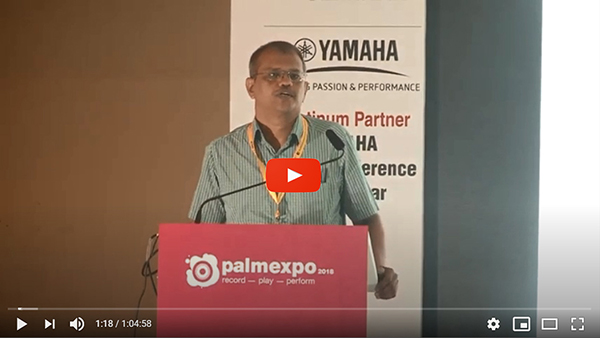PALM Education Series - Acoustics in Auditorium Design
Acoustics In Auditorium Design
by Vijay Purandare

Importance of Acoustics in Auditorium Design
How a room sounds and feels depends heavily on the specific acoustic properties of the materials in the room. For example, the acoustics of a concert hall are designed in such a way that the music of the orchestra is amplified by natural reverberations. The conception of an auditorium for first-class sound quality begins with the basic layout of each room to ensure that sound waves are distributed evenly across the room.
The aim of high-quality auditorium acoustics is the equal distribution of sound for the seated audience regardless of where they are seated in the auditorium. Architects and builders rely on acousticians to reduce the distance that sound will travel and increase it. This includes advice on the acoustic design of the auditorium and the provision of acoustic design treatments tailored to the audiovisual media and the acoustic environment of the auditorium itself.
The key to sound acoustic is to find a balance between building materials and floor plan that allows you to absorb and reflect sound waves while designing the building.
Vijay Purandare conducted a seminar it is a presentation on ACOUSTICS IN AUDITORIUM DESIGN at the PALM Conference & Seminar in 2018 wherein he spoke about the Acoustics for Auditoriums and how any good acoustical design should be near perfect combination of reflection, diffusion & absorption of sound energy.
According to Vijay Purandare, “It is always our effort that the performer in the auditorium and the audience in the auditorium to experience the best possible audio-visual experience. When it comes to architectural acoustics it is the branch of engineering and we focus on three components, communication, comfort and privacy in architectural design”.
Acoustics in Auditorium Design
When talking about acoustics when designing a particular room or a particular space for acoustics it is designed not for machines, but for humans to listen a frequency or a program. When it’s at auditoriums, it is for noise control, speech clarity and acoustic gain; when it is for cinemas it is for noise control, dialogue clarity, and surround sound field are some additional factors that needs to be considered while designing cinemas. For classrooms noise control, overall acoustical comfort, speech clarity are the factors when we talk about acoustics; it is noise control and overall comfort of the people. In an office it is noise, comfort and crosstalk in between the cabins and in homes and hotels again, noise control, comfort and privacy.

This can be sub divided in two parts. One is control of noise and soundproofing and the other part as a room acoustics that is internal acoustics of any room which deals with absorption, reflection and diffusion of some and third is electro acoustics. When it comes to noise, it can be simply defined as unwanted sound by mistake or by some way. Many people think that all the noise is always bad. But as a friction in mechanical engineering noise is also good and helpful when it is in the right amount at the right place.
Practically every space demands acoustic attention in order to function for its specified purpose like:
Auditoriums – for noise control, speech clarity and acoustic gain
Cinemas – noise control, dialogue clarity, surround sound field
Classrooms – noise control, comfort and speech clarity
Factories – noise control and comfort
Offices – noise, comfort and cross-talk i.e., privacy
Homes/Hotels – noise, comfort, and cross-talk i.e., privacy
Architectural Acoustics can be sub-divided into:
- Noise and soundproofing
- Room Acoustics – absorption/reflections/diffusion
- Electro Acoustics – Audio System
Noise & Soundproofing
Noise can be simply defined as unwanted sound.
Control of noise is useful in:
- Achieving Speech Clarity – less is better
- Reduce cross-talk – increase privacy – more is better
- Increase in comfort – moderate is better
Noise in Auditorium
When it comes auditorium, it is always that lesser is better and ways to improve on the noise or controlling the noise is, closing all air gaps by increasing the surface density of the partitioning walls by using thicker walls, high density materials, cavity walls filled with absorbing materials, like glass wall, that also helps. Glass wall itself will never help you in isolating or soundproofing. Many people try to use glass wall or thermal insulators, as acoustical insulators or acoustical barriers, although these thermal insulators are very good sound absorber in mid and higher frequencies, but on itself, they will never stop the sound to move from one side to the other side. In a cavity, what result we get is, when there are two walls in between the isolation, one wall will vibrate, it will generate a secondary wave, the secondary wave will hit another wall, that will again vibrate and produce sound at the other end, that in between transition of the sound will get absorbed by use of the glass wall, that is the use of glass wall in sound absorption, in fact any absorbing material.
When it comes to noise in auditorium, why noise control or mic reduction is important it is because there is a limit to gain before feedback. You can put whatever audio system, whatever amplifiers, whatever microphones, there is a limit to that volume control, beyond certain limit it will start whistling, it will start giving feedback and beyond that, no one is able to achieve more gain in electronic system. The other way we can improve the signal to noise ratio is nothing but to reduce the noise and especially when it comes to drama auditorium, which is the critical most auditorium application, it becomes very critical to achieve even that 15 dB of signal to noise ratio and for that, when it comes to performing arts auditorium noise control becomes very critical.
- Due to the limit of ‘gain before feedback’, noise is very critical.
- Should be as less as possible
- Any increase in noise always masks the original signal
- For perfect speech clarity S/N ratio should be minimum 15dB
- In general, it should follow NC35 and NC30 specifically for Drama (including A/C & Electrical)
Noise Control results depends on
The result of noise control depends on the perfection in design, implementation of the design at site, and understanding of the subject by the workers who are working at the site. Unless the worker doesn’t understand why there should not be any air gaps, he will never work for that and unless he understands the subject or understand the necessity of the design, the implementation or results will not be fully acceptable.
- The perfection of design
- Implementation of the design
- Understanding of the subject by actual works
Room Acoustics
The purpose is to achieve:
- Comfort – through noise control
- Speech Clarity – through absorption and reflections
- Liveliness of Music – through diffusion and reflections
- Acoustic Gain – through reflections
Large Room Acoustics
When it comes to auditorium acoustics or large room acoustics this is how the criticalness goes on increasing (as shown below). Open air auditorium is the simplest form as far as acoustics is concerned to design provided it is at a remote place or the noise level there is less than 35,30,25 dB. Semi open hall or Sabha Mandap, the classical example of this we see at many of our Indian temples. Then there is multipurpose hall and music auditorium, then corporate auditoriums can be considered because in corporate auditoriums microphones are always close to the mouth. In cinemas there is no live performance and all the material is recorded, and performing arts and drama auditorium is the most critical application. For all these applications, lesser the noise is good, this will increase the signal to noise ratio and also the speech clarity.
- Open Air Auditorium
- Semi Open Hall (Sabha Mandap)
- Cinema
- Multipurpose Hall
- (Mostly in schools or indoor stadiums)
- Music Auditorium
- Corporate Auditorium
- (For presentation, conference, lecture)
- Performing Arts & Drama Auditorium
Reverberation Time RT60
Reverberation Time is the most discussed factor or parameter in acoustics. It is important but not the only important parameter. Many times, people try to calculate only this reverberation, absorption, it is driven by the material manufacturers also because a manufacturer will never talk about other materials. It is time taken by the sound energy to decay by 60 Db from the original when the original sources stop.
- Important (but not the only) factor in room acoustics
- Reverberation is stored energy of sound waves which gradually decay
- It is the time taken by the sound energy to decay by 60dB
- Speech clarity directly related (Inv proportion) to RT60
- Optimum reverberation required for liveliness of sound
Diffusion of Sound
Diffusion of sound is another important parameter; this is very important to create liveliness in the experience of sound. Another importance of diffusion is for all acoustical calculations, it is considered that the sound field in a particular room is diffused. If we try to calculate absorption or calculate reverberation in a parabolic shape of the ceiling, where the sound waves are highly focused, the calculations and the actual practical results when measured will be largely different.
- Diffused sound field is always needed (and is basic assumption in all acoustical calculations) for natural, lively experience of the performance.
- This can be achieved by providing proper acoustical diffusers or using some interior decoration items as diffusers.
Acoustical Reflections
Acoustical Reflections is again an important factor, however somewhat neglected in overall auditorium design or acoustical design.
- Important but somewhat neglected
- Sound we hear in any enclosed hall is a combination of direct & reflected sound
- All reflections directly affect the definition of sound
Acoustical Reflections can be divided into:
- Early Reflections – good and normally adds to improve the definition of the sound and increase the clarity
- Late Reflections – bad reflections and ruin the clarity
- Reverberation – Reverberation is really a function of very late and diffused reflections
Conclusion
Acoustical treatment of any auditorium is a carefully designed combination of Absorption, Reflection and Diffusion fluently merged with interior in a noise controlled envelop to improve the connection between the performer and the audience.